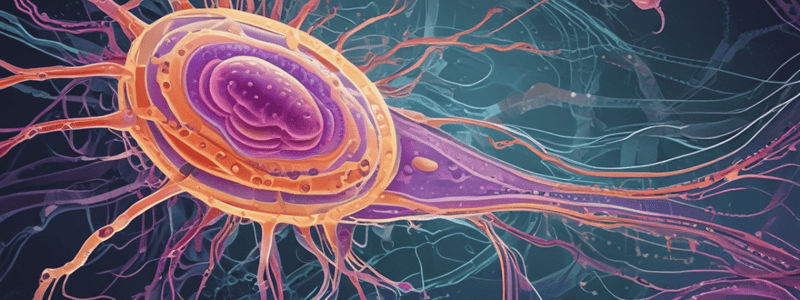Podcast
Questions and Answers
What are the two types of rotation for bacterial flagella?
What are the two types of rotation for bacterial flagella?
- Left (L) and Right (R)
- Up (U) and Down (D)
- Clockwise (CW) and Counterclockwise (CCW) (correct)
- Forward (F) and Backward (B)
How does a bacterium respond to an increase in an attractant's concentration?
How does a bacterium respond to an increase in an attractant's concentration?
- By changing its color
- By increasing its size
- By altering the CW:CCW ratio to move up the gradient (correct)
- By staying in one place
What is normal bacterial movement composed of?
What is normal bacterial movement composed of?
- Jumps and slides
- Turns and spins
- Runs and tumbles (correct)
- Flips and rolls
What characterizes chemotaxis?
What characterizes chemotaxis?
How many serotypes exist for Salmonella spp. based on O and H antigens?
How many serotypes exist for Salmonella spp. based on O and H antigens?
What is phase variation in Salmonella spp.?
What is phase variation in Salmonella spp.?
What is a fundamental structure characteristic of flagella?
What is a fundamental structure characteristic of flagella?
Which component of a flagellum connects the filament to the motor?
Which component of a flagellum connects the filament to the motor?
Which type of flagellar arrangement is found in Escherichia coli?
Which type of flagellar arrangement is found in Escherichia coli?
What is the typical visibility of flagella under a light microscope?
What is the typical visibility of flagella under a light microscope?
Which bacteria is known for having a monotrichous flagellar arrangement?
Which bacteria is known for having a monotrichous flagellar arrangement?
What protein composes flagella?
What protein composes flagella?
What anchors the basal body of the flagellum in bacterial cells?
What anchors the basal body of the flagellum in bacterial cells?
In Gram-negative bacteria, where is the outermost ring of the basal body located?
In Gram-negative bacteria, where is the outermost ring of the basal body located?
What role do Mot proteins play in the flagellar basal body?
What role do Mot proteins play in the flagellar basal body?
The energy required for the rotation of the flagellum is supplied by what mechanism?
The energy required for the rotation of the flagellum is supplied by what mechanism?
Approximately how many genes are involved in flagellar motility in E. coli and S. typhimurium?
Approximately how many genes are involved in flagellar motility in E. coli and S. typhimurium?
Which type of flagella movement is described as rapid spinning?
Which type of flagella movement is described as rapid spinning?
Flashcards are hidden until you start studying
Study Notes
Chemotaxis Driven by Flagella Rotation
- Flagella can move in two ways: clockwise (CW) or counterclockwise (CCW) rotation.
- The direction of flagella rotation is influenced by the concentration of a substance that the bacteria is attracted to.
Motility and Chemotaxis
- Normal movement of bacteria is composed of runs and tumbles.
- Chemotaxis is a response to different chemical gradients, where bacteria compare the chemical state of the environment to that sensed seconds before and move up or down the gradient accordingly.
- By altering the CW:CCW ratio, bacteria can move up or down the gradient.
Flagella Antigens and Phase Variation
- Salmonella spp. are typed by their O (LPS) and H (flagellar) antigens.
- There are over 2000 serotypes of Salmonella spp. due to different O and H antigens.
- Phase variation allows bacteria to differentially express protein antigens as either phase 1 or phase 2.
Flagellar Structure
Flagellar Basal Body
- The basal body is anchored in the cytoplasmic membrane and cell wall.
- The basal body consists of a small rod passing through a system of rings.
- Gram-negative bacteria have multiple rings, including an outer ring in the outer membrane/LPS, one in peptidoglycan, one in the cytoplasmic membrane, and one in the cytoplasm.
- Gram-positive bacteria have one fewer inner ring.
Flagellar Motor
- Two Mot (motor) proteins are anchored either side of the MS ring.
- The Mot proteins drive the flagellar motor, causing a torque that rotates the filament.
- The Fli proteins act as a motor switch.
- Energy is supplied by the passage of protons from outside the cell into the cytoplasm via the basal body mot complex.
Flagella Genetic Control
- Over 40 genes are necessary for motility in E. coli and S. typhimurium.
- The genes are grouped into fla, fli, and flg.
- These genes have several functions, including structural proteins, exporting of flagellar components, and biochemistry of synthesis.
Flagella Motility
- Flagella enables movement at a rate of up to 60 cell lengths per second.
- Movement is different in polar and peritrichous flagella.
Peritrichous
- Movement occurs in a straight line with counter-clockwise rotation.
- Tumbling occurs with clockwise smooth swimming.
Polar
- More rapid spinning occurs.
Flagella
- Flagella are long, thin appendages that originate from the cytoplasmic membrane and extend through the cell wall into the surrounding medium.
- They enable bacteria to be mobile.
- Flagella are very thin (20nm) and not visible by light microscope unless stained.
Flagellar Arrangement
- Monotrichous flagella have one flagellum (e.g., Vibrio cholerae).
- Lophotrichous flagella have multiple flagella on one end (e.g., Bartonella bacilliformis).
- Amphitrichous flagella have flagella at both ends (e.g., Spirllum serpens).
- Peritrichous flagella cover the surface of the bacteria (e.g., Escherichia coli).
Flagellar Structure
- Flagella have a fundamental helical structure with a constant distance between adjacent curves (wavelength).
- The wavelength is constant for a given organism.
- Flagella are composed of protein subunits of flagellin.
Studying That Suits You
Use AI to generate personalized quizzes and flashcards to suit your learning preferences.




